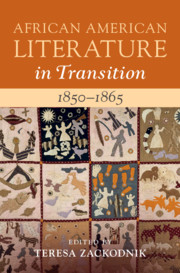Book contents
- African American Literature in Transition, 1850–1865
- African American Literature In Transition
- African American Literature in Transition, 1850–1865
- Copyright page
- Contents
- Figures
- Contributors
- Preface
- Chronology, 1850–1865
- Introduction
- Part I Black Personhood and Citizenship in Transition
- Part II Generic Transitions and Textual Circulation
- Part III Black Geographies in Transition
- Bibliography
- Index
Part II - Generic Transitions and Textual Circulation
Introduction
Published online by Cambridge University Press: 07 April 2021
- African American Literature in Transition, 1850–1865
- African American Literature In Transition
- African American Literature in Transition, 1850–1865
- Copyright page
- Contents
- Figures
- Contributors
- Preface
- Chronology, 1850–1865
- Introduction
- Part I Black Personhood and Citizenship in Transition
- Part II Generic Transitions and Textual Circulation
- Part III Black Geographies in Transition
- Bibliography
- Index
Summary
The five chapters that comprise Part II of this volume take up literary imagination and experimentation, as well as textual circulation, as explorations of political possibility. Centered on texts published in the 1850s and early 1860s, Chapters 5 and 6 focus on the novel and poetry to consider how African Americans wrote in these genres by exploiting their capacities for distinctive ends. In Chapter 5, Hollis Robbins and Mark Sussman consider Bahktin’s theories of the novel as not only heteroglossic, but also a “literature of private life … of snooping about, of overhearing” private content in a public form. The early African American novel and slave narratives “politicized” this defining generic characteristic, they argue, exposing the “compromised privacy and surveilled speech” endemic to slavery as preconditions of “insurgent listening.” Harriet Jacobs’s Incidents of the Life of a Slave Girl, Frederick Douglass’s The Heroic Slave, Frank Webb’s The Garies and Their Friends, Harriet Wilson’s Our Nig, and Hannah Crafts’s The Bondwoman’s Narrative are read through an attention to the sonic and overhearing that reveals the novel as both a “contested literary form” and a way of “representing contested space and power.”
- Type
- Chapter
- Information
- African American Literature in Transition, 1850–1865 , pp. 119 - 242Publisher: Cambridge University PressPrint publication year: 2021

